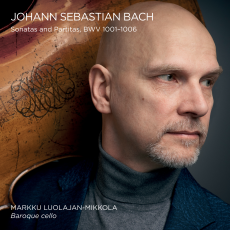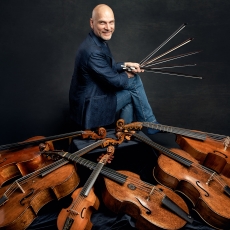Markku Luolajan-Mikkola - J.S. Bach: Complete Sonatas & Partitas - Hi-Fi+
This fine recording of the six Partitas and Sonatas is a rarity since these works are well known as pieces for solo violin. But, in accordance with conventions with which Bach himself adopted, these suites and sonatas have been lovingly transcribed by the celebrated baroque cellist, Markku Luolajan-Mikkola, for his instrument. In the transcription the works have been transposed down an octave and a fifth to enable the cello double, triple, and quadruple stopping that these pieces require. The three Sonatas follow the church sonata pattern, and each one has a fugue as its second movement, which are the dramatic and emotional core of the Sonatas, while the Partitas include dance forms, - sarabandes, gigues and chaconnes. The musicality of Luolajan-Mikkola's performance commands respect as does the sheer dexterity of his playing, especially in his magisterial account, for example, of the Presto in the Partita No 1 in E minor (transcribed from the original key in B minor). It is such an exuberant display that we are left almost breathless with excitement, only to be brought seamlessly to the contrasting plangency of the Sarabande - a kind of palate cleanser before returning to the extraordinary polyphonic effects of the Tempe di Borea and its Double which brings that Partita to its close.
In the second Partita in G minor, the courtliness of the opening movement gives way to the running figure of the Corrente, which in this essay in contrasts brings us to a station of stillness in a measured Sarabande. And having got our breath back we are soon back on track again with the wit of a fast moving jig. An epic and unutterably beautiful Ciaccona (or Chaconne - which surpasses in duration the previous four movements combined) pulls out all the double stops as it rounds off this Partita. This Chaconne must be one of the greatest works ever written for solo violin, and its transference to the solo baroque cello does the work * no disservice. The third Partite in A major is the last work in this set of Partitas and Sonatas, and its Prelude was used by Bach again in at least two of his Cantatas, while the well known Gavotte en Rondeau is familiar to us as a standalone piece often accompanying radio and TV programmes. Sonata No 1 in C minor (originally G minor) begins with a solemn Adagio which leads into a magnificent Fugue. Writing a fugue for a single line instrument is extraordinary - but Bach is the master of the art of fugue and Luolajan-Mikkola is a consummate master of the technical challenges which such fugal writing presents. The contrasting Siciliana creates a reflective mood before plunging into a relentlessly energetic Presto played again with unerring articulation and dexterity until the movement brings the Sonata to its perfect cadence.
In the second Sonata in D minor, the improvisatory Grave leads into a Fugue where Bach's inventiveness flows between the fugal episodes. The Andante has the melody flowing over a repeated pedal note ostinato, and the Sonata concludes with a perpetual motion Allegro with the light and shade of the movement enhanced by echo effects which L-M's deft playing demonstrates to great advantage. The third Sonata in C minor (originally in G minor) plumbs the darker landscape of minor key reflectiveness in its opening Adagio, with its pulsating, questioning ostinato. The lengthy fugal movement which follows continues the interrogative vein of this Sonata until it blossoms into exuberant exercises which display the upper register of the cello. The expressive loveliness of the Largo to which this performance gives due weight with nicely judged rubato and portamento, leads us into the finely-fingered helter skelter of the final Presto - all the more vital thanks to the almost visceral directness of the baroque instrument. This is a recording to be recommended. The recording quality is outstanding, too; the ambience of St Catherine's Church in Karjaa, Finland where it was recorded matches the quality of the interpretation and the performance of these great works.

